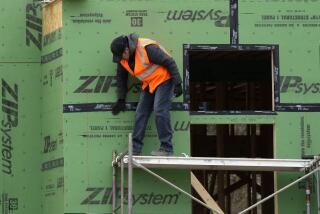Unemployment at 7.2% for Fifth Month as Manufacturing Continues to Lose Jobs
- Share via
WASHINGTON — The unemployment rate in June remained unchanged at 7.2% for the fifth month in a row, the Labor Department reported Friday, as manufacturing employment continued to slide while the service sector added 85,000 new jobs.
The overall unemployment rate would have climbed significantly if there had not been a shrinkage of nearly 600,000 workers in the seasonally adjusted labor force. Analysts attributed the change to statistical quirks caused by a lower than expected level of teen-age job seekers moving from school to the workplace as the summer began. Although the number of workers actually rose in June, the increase was less than the Bureau of Labor Statistics considers normal.
Figures Troublesome
In the last few years, the bureau has had trouble adjusting its unemployment figures in May, June, and July to account correctly for the uneven surge of workers into the labor force at this time of the year.
The civilian unemployment rate, which does not include members of the armed forces stationed in the United States, also remained steady, at 7.3%.
In California, the official civilian unemployment rate jumped to 7.8% in June from 7.1% the previous month, a surge that also may have been due to statistical aberrations. For Los Angeles County, where the unadjusted unemployment rate climbed from 7% in May to 7.7% in June, a seasonal adjustment done by First Interstate Bank pointed to an unchanged unemployment rate of 7.4% for both months.
Many economists still expect unemployment to move up slightly this year, as weakness in the economy forces companies to reduce hiring of new workers. “The unemployment numbers continue to tell a story of an economy that is going sideways,” said David Wyss, a senior economist at Data Resources Inc., a forecasting firm in Lexington, Mass. “It isn’t getting a lot worse, but it isn’t getting a lot better, either.”
Improved Economy Seen
But other economists were more sanguine, convinced that the economy is about to pick up speed again after a yearlong period of lackluster growth. “The rebound that is now under way is likely to prevent any erosion in unemployment,” said Richard Rahn, chief economist at the U.S. Chamber of Commerce. “And the economy is actually a lot stronger than government measurements indicate. The official statistics haven’t done a very good job of keeping up with the changing structure of the American economy.”
Total non-farm employment, according to a survey of payrolls that government analysts consider a more accurate measure of shifts in employment, was virtually unchanged at 97.5 million jobs. A survey of households, used to compile the official unemployment data, showed a seasonally adjusted decline in civilian employment of 590,000 along with the equivalent fall in the labor force, leaving the unemployment rate at the same level it has been since February.
More Service Jobs
But, hidden behind the apparent stability in the job figures is an acceleration in the long-term trend away from manufacturing and toward employment in service industries.
Since the recovery began at the end of 1982, manufacturing has regained only 58% of the jobs lost in the last recession, prompting Commissioner Janet L. Norwood of the labor statistics bureau to point out in congressional testimony the “extent of the employment restructuring that has occurred in the nation’s factories.” Five industries--steel, textiles, chemicals, petroleum and coal products--have actually lost jobs during the recovery period, and several others have regained less than half of the jobs lost in the recession.
Manufacturing employment declined by 45,000 in June, leaving the nation’s factories with 220,000 fewer workers than at the beginning of the year.
However, Norwood disputed the idea that the shift from manufacturing to services is seriously undermining the long-term health of the economy. “A lot of people believe the United States is losing good jobs and gaining bad jobs. There is a view that we are becoming a nation of hamburger makers,” she said. “That is not true. There seems to be a shift out of lower-paying occupations into higher-paying occupations.”
Sen. William Proxmire (D-Wis.) complained that the economy is stuck at an unacceptably high unemployment level for a nation that has enjoyed improved prosperity for the last 2 1/2 years.
The unemployment rate, Proxmire said, “is very, very high . . . a real recession level.”
Fewer Get Jobless Pay
At the same time, fewer jobless workers are receiving unemployment benefits, according to an analysis released Friday by the Center on Budget and Policy Priorities. Only 26.9% of the unemployed received benefits in June, a record low, leaving 6.4 million workers without unemployment insurance payments. Most have used up normal benefits at a time when extended benefits have been rescinded.
The center’s report, based on Labor Department statistics, pointed out that the percentage of unemployed receiving benefits is less than half of what it was in 1980, when overall unemployment was at about the same level.
According to the Bureau of Labor Statistics report, unemployment among adult men climbed to 6.5% in June from 6.1% the previous month, but the jobless rate for adult women was down to 6.7% from 6.9%. For blacks, the unemployment rate dropped to 14% from 15.6%, and the white jobless rate rose to 6.5% from 6.2%.
More to Read
Inside the business of entertainment
The Wide Shot brings you news, analysis and insights on everything from streaming wars to production — and what it all means for the future.
You may occasionally receive promotional content from the Los Angeles Times.










